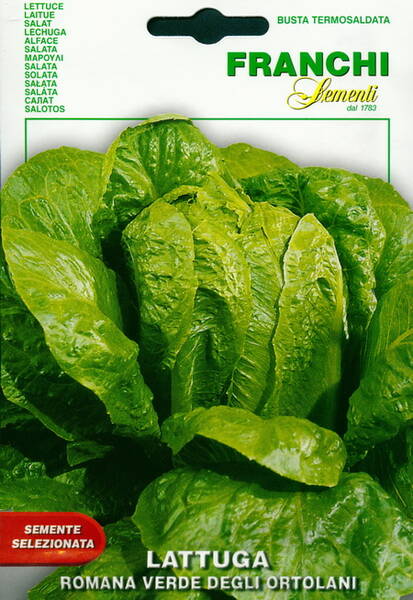Ex Tax: 1.20€
Medium early variety.
To obtain early production, they are grown through seedlings (sowing seeds in greenhouses: April - May).
You can grow this salad in the summer crop rotation. Moisture-loving. Landing chart 30 x 30 cm.
Romaine lettuce (or romano) refers to the head subspecies of lettuce. Moreover, a head of romaine lettuce is distinguished by its looseness and delicate nutty taste of its juicy green leaves.
This variety is mid-early (full ripening 90 days after sowing), which is grown from spring to autumn in open ground.
To obtain early products, they are grown through seedlings (sowing seeds in greenhouses: April - May). 1.0 g = 800-1100 seeds.
Very light and moisture-loving. Landing pattern 30 x 30 cm.
* Romaine lettuce is sown from early July to late August for autumn consumption. The seeding rate of head varieties with one breakthrough is up to 2 kg/ha, with two - 2.5-3.0 kg/ha.
With a seedless method of cultivation, a double thinning is carried out. The seeding rate of leafy varieties with continuous sowing is 4-7 kg/ha.
The seedling method of cultivation is used to obtain an early harvest. First, seedlings are grown, which are then dived into pots or peat-muck cups ranging in size from 3x3 to 6x6 cm, depending on the period of seedling preparation. To obtain seedlings, seeds are sown 30 ... 35 days before planting in the field. 0.5 g of seeds are sown in one box (20 ... 25x40 cm). At a temperature of +20+22°C shoots appear in 2-3 days, after which the temperature is reduced to +10+12°C. In the real leaf phase, the seedlings dive into cubes or pots, pre-watered abundantly. When landing, the cube is buried no more than two-thirds of the height.
Care of crops consists in shallow loosening of row-spacings, weeding and watering in dry weather. The irrigation regime affects the concentration of nitrate ions in plants, especially at high temperatures. During the formation of heads, watering is carried out only along the furrows.
Harvesting is carried out in the evening or early in the morning, when the plants are cooled and therefore better retain their fresh presentation.
In terms of its properties, romaine is similar to late-ripening varieties of head lettuce, but differs from them in unpretentiousness, resistance to bolting, and a longer shelf life.
Roman lettuce is cold-resistant, well-hardened seedlings can withstand temperatures as low as -3°C. But during the period of head formation, even the lightest frosts adversely affect the further growth of plants.
Roman lettuce is very picky about high light, although it can adapt to very little shading. Shaded places are not suitable for him, because. with a lack of light, heads of cabbage are formed small and very loose.
Like all head lettuce, Roman lettuce is demanding on high soil moisture, but does not tolerate waterlogging, since prolonged rains lead to rotting of plants. At the same time, the lack of moisture in the soil negatively affects the size and density of the head and can cause premature stalking of plants. At the same time, the leaves are very bitter and not everyone will like it.
Eng.: Roman lettuce, Cos lettuce. Bot.: Lactuca sativa var. capitata.
* Romaine lettuce with tomatoes.
60 g romaine lettuce, 50 g tomatoes, 5 g green onions, 2 g parsley, 2 g dill, 30 g salad dressing, salt to taste.
A large head of romaine lettuce is cleaned from the top leaves, washed, dried and coarsely chopped, poured with salad dressing.
Carefully mix and place in a salad bowl in a slide, surrounding it with semicircles of red tomatoes, paws of endive or watercress and sprinkled with green onions.
Romaine lettuce is served as an independent dish for a snack or as a side dish for meat and fish products.
* Romaine lettuce with oranges and bananas.
180 g romaine lettuce, 90 g oranges, 90 g bananas or apples, 90 g salad dressing.
Cut the romaine lettuce, add oranges and bananas or apples, cut into thin slices, pour over the salad dressing.
Put in a salad bowl with a slide and sprinkle with orange zest. Salad can be eaten as an appetizer or served as a side dish to fried meat, poultry, fish.











